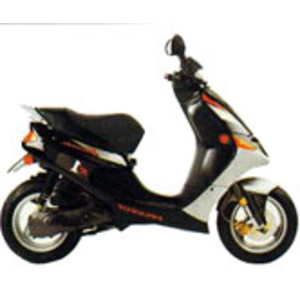Peugeot Speedake 50 (1995-2007): A Timeless Urban Companion Revisited
Introduction
The Peugeot Speedake 50 represents an era when simplicity and practicality ruled the streets of Europe. Produced from 1995 to 2007, this 50cc two-stroke moped became a staple for urban commuters, delivery riders, and teenagers craving their first taste of freedom. While modern electric scooters now dominate cityscapes, the Speedake 50 remains a beloved relic – a machine that prioritizes straightforward mechanics over flashy tech. After spending a week with a well-preserved 2003 model, it's clear why this French-designed workhorse still has a cult following today.
Design & Build Quality
The Speedake 50's design language screams late-'90s utilitarianism. Its angular plastic fairings (available in colors like Mars Red and Alpine White) wrap around a tubular steel frame with zero pretenses of sportiness. The flat, bench-style seat prioritizes durability over comfort, while the high-rise handlebars create an upright riding position perfect for navigating traffic.
Build quality is surprisingly robust for its price category. The metal footpegs withstand daily abuse, and the 10-spoke alloy wheels feel durable despite their small 10-inch diameter. However, the plastic panels – while resistant to fading – develop rattles over time, especially around the glove compartment area. The analog dashboard is refreshingly basic: a speedometer, fuel gauge, and warning lights that even a novice can decipher.
Performance & Riding Experience
Don't let the 49.9cc two-stroke engine fool you – this is a characterful powerplant. The air-cooled single-cylinder delivers 4.2 PS (3.1 kW), translating to a top speed of 45 km/h (28 mph) in stock form. What it lacks in power, it makes up for in responsiveness. The carbureted engine thrives in stop-and-go traffic, with a satisfying brap from the exhaust every time you twist the throttle.
Riding the Speedake feels like conducting a mechanical orchestra: - The CVT transmission eliminates gear changes, making it ideal for beginners - Acceleration from 0-30 km/h (0-18.6 mph) takes ~7 seconds – leisurely but adequate for urban use - Fuel economy shines at ~35 km/l (82 mpg), giving a 189 km (117 mi) range from its 5.4L tank
Vibration is noticeable at higher revs, but the rubber-mounted footpegs dampen most discomfort. The engine's 1,800 ± 100 rpm idle speed ensures smooth stoplight departures, though cold starts require patience with the manual choke.
Handling & Braking
Weighing just 86 kg (190 lbs), the Speedake 50 dances through traffic like a bicycle. The short wheelbase and 120/70-10 tires (front and rear) allow razor-sharp U-turns, while the suspension – basic telescopic forks up front and dual shock absorbers at the rear – soaks up potholes better than expected.
Braking relies on: - Front: 190mm drum (adequate for sub-50 km/h speeds) - Rear: 110mm drum (requires firm pedal pressure)
Maintain the recommended tire pressures (1.3 bar/19 psi front, 1.6 bar/23 psi rear) for optimal grip. Wet weather performance is mediocre – the narrow tires hydroplane easily, so avoid aggressive cornering after rain.
Competition
In the 50cc class, the Speedake 50 faced fierce rivals:
| Model | Key Differences | Advantage | |----------------|------------------------------------------|-----------------------| | Honda NSR50 | Liquid-cooled, sportier styling | Higher top speed | | Aprilia SR50 | Aerodynamic design, rotary valve engine | Better acceleration | | Piaggio Ciao | Step-through design, larger storage | More practical |
The Speedake's strengths lie in its mechanical simplicity and low maintenance costs. Unlike the temperamental Aprilia SR50 (which demanded frequent carb cleans), the Peugeot's basic two-stroke design forgives irregular servicing. It also undercuts the Honda NSR50 in part availability – a boon for DIY owners.
Maintenance & Upkeep
As a MOTOPARTS.store journalist, I prioritize longevity. Here's how to keep your Speedake 50 running smoothly:
1. Engine Care
- Use JASO-FD certified 2T oil (900ml capacity) – we recommend MOTOPARTS.store #MP-2TOIL
- Replace spark plugs every 3,000 km:
- Standard: NGK B7HS (#MP-NGKB7HS)
- Iridium upgrade: NGK BR7HIX (#MP-NGKB7HIX) for better cold starts
2. Brake System
- Flush DOT 4 fluid annually (#MP-DOT4BRAKE)
- Sand brake shoes every 5,000 km to remove glaze
3. Drivetrain
- Change final drive oil (120ml 85W-140) every 10,000 km (#MP-GEAR85W140)
- Lubricate throttle/choke cables with PTFE spray (#MP-CABLELUBE)
4. Tires
- Upgrade to MOTOPARTS.store #MP-CITYGRIP tires for wet weather traction
- Check pressures weekly with our #MP-DIGITALGAUGE
5. Winter Storage
- Add fuel stabilizer (#MP-FUELSTAB)
- Disconnect battery (or use trickle charger #MP-BATTMAINTAIN)
Customization Potential
The Speedake 50's aftermarket scene thrives in Europe. Popular MOTOPARTS.store upgrades include: - Performance: Malossi 70cc big bore kit (#MP-MALOSSI70CC) - Aesthetics: LED turn signals (#MP-LEDSIGNAL) + chrome exhaust (#MP-CHROMEEXH) - Comfort: Gel seat cover (#MP-GELSEAT) - Storage: Rear rack + 25L top case (#MP-TOPCASE25)
Conclusion
The Peugeot Speedake 50 isn't about speed or style – it's about freedom without complications. Thirteen years after production ended, it remains a testament to no-nonsense engineering. Whether you're restoring a barn find or daily-riding a weathered example, MOTOPARTS.store has the components to keep your Speedake alive. From OEM-spec NGK plugs to wild Malossi upgrades, we cater to purists and modifiers alike.
This plucky French moped proves that sometimes, less really is more – especially when "less" comes with a 28 mph grin.

















